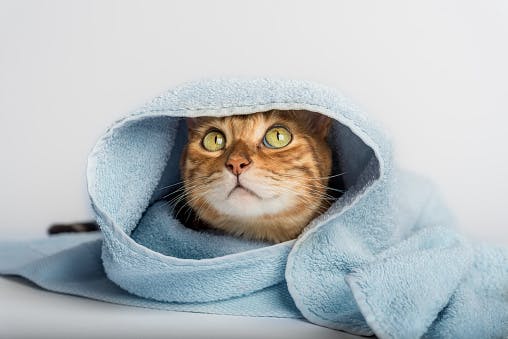Whether it is necessary to bathe cats or whether the pet is able to keep the coat clean on its own, how often it is necessary to make a full bathe - these questions concern every pet owner. Despite the excessive cleanliness of a pet, periodic bathing in the bathroom is a necessary measure that should become an obligatory step in regular pet care.
Washing a cat at home is not an easy task, especially if she is not accustomed to bath procedures from an early age. If it is the cat with claws, the animal scratches break out, and when you are trying to keep the animal still, you get a cruel punishment. The result is scratched hands, damaged nerves, sprained paws, and a frightened pet. Here's how to wash your cat the right way, safely and stress-free for both of you.
Do Cats Need Baths?
If dogs swim in the water with pleasure, not everyone can bathe a cat. It will take iron endurance and stress resistance to bathe a cat. To prevent shampooing a cat from becoming a global catastrophe, it is important to know the correct sequence and technique of bathing and also not to resort to water procedures without urgent need.
You need to bathe the animal in cases:
preparation for exhibition events;
fur infection with parasites (cat with fleas, for example);
severe pollution that cannot be washed without a bath;
clean the cat if there is a persistent unpleasant odor.
It is recommended to regularly bathe a cat that is walking outside, especially if there are other animals or small children with allergies in the house. In rare cases, the pet expresses a desire to be bathed. In such cases, the frequency of bathing can be increased; just try not to use shampoo every time.

How Often Should You Bathe a Cat?
Veterinarians and breeders are encouraged to bathe Fluffies as needed and the degree of soiling of the coat. If the animal sheds, emergency water procedures will facilitate the removal of old hair, thereby preventing the frequent formation of hairballs in the animal's esophagus.
To correctly determine the frequency of bathing, consider the following factors:
the general condition of the pet;
cat's attitude to water;
stress level;
the age of the pet;
density and length of hair.
It is enough to wash the cat in the bathroom 2-3 times a year, exhibition animals are washed more often - 5-7 times yearly. It is not recommended to bathe short-haired cats often, representatives of the Siamese breed, Orientals and Rex, may be well without regular baths.
Preparing for Your Cat's Bath or How to Bathe a Cat, Step-by-Step
To wash a cat that is afraid of water without unpleasant consequences, it is important to prepare for the procedure properly. Here are some tips to help make this activity safe and fun:
Purchase special detergents in advance. Washing a cat with human shampoo or soap is a bad idea. Such hygiene products can cause allergies in the animal, dry skin (due to different levels of acidity), not to mention the consequences of getting into the mouth and eyes.
Trim your pet's nails a few days before bathing. This will allow you to bathe a cat without getting scratched.
Plan a good time - it is better to choose a period after a cat's prolonged physical activity when he is tired and wants to relax. To do this, you can especially go for a walk or play with a laser pointer with your pet.
Comb out excess wool; this is especially important if the animal is a long-haired breed. Fur will get matted and will interfere with washing, periodically delivering discomfort to the cat.
Prepare a bathing place for the cat at home. Turn on the water at the desired temperature in advance (35-36 degrees Celsius). It is better not to turn on the noisy faucet in front of a cat who hates water. Lay a piece of cloth or a rubber mat on the bottom of the bathroom (basin, sink) to ensure reliable grip and stability.
Prepare yourselves - it is important to be calm and friendly, and nervousness and irritability will definitely be transferred to the pet.
To safely wash a cat, you can give her sedatives, but only on the recommendation of a veterinarian and strictly observing the dosage.
Where to Bathe Your Cat
The first option is to wash the cat in the bath. The convenience is that the bath has high sides, and the cat will most likely not be able to reach them. Keep in mind that cats cling to everything with such force that it feels almost impossible (or at least very difficult) to tear them off.
Everything that can fall on, everything that can break, everything that can be grabbed must be removed. At the bottom of the bath, you should put either a towel, a bath mat, or any rag. The fact is that the enamel with which the bath is covered becomes slippery from water and shampoo, and the cat will feel insecure on such a surface and become even more nervous.
The water temperature should be no higher than 37-38 degrees. If it's cooler, don't worry. Cats react worse to hot water. And don't run a full bath. Let the water reach the stomach or slightly cover the sides.

Supplies You'll Need to Bathe Your Cat
It is strictly forbidden to wash a pet with cosmetics intended for humans. The fact is that shower gels and soap can provoke dermatitis and allergies, and worsen the condition of the coat, making it dull and unattractive. You can buy shampoo:
dry shampoo;
spray;
liquid.
To facilitate combing, reduce shedding, and moisturize the coat, groomers recommend using conditioners and leave-in sprays.
Dry shampoo is a good choice for those who want how to bathe a cat without water. Following the instructions, you need to apply the detergent to the coat, wait 2-5 minutes and start combing. Sprays provide easy application, are easy to use, guarantee high-quality cleaning of the coat, make the fur coat shiny, and facilitate further care. Liquid shampoos can be selected in accordance with the breed of the animal; you can purchase products with a therapeutic effect - for sensitive skin prone to dermatological diseases and allergies and for the treatment of ectoparasites.
Tips for Keeping Your Cat Calm or How to Hold Your Cat
How to wash a cat at home without a nervous breakdown? First of all, don't force your pet into the bathroom. The cat should voluntarily enter the bathroom and feel safe. When the first step is taken, and the pet is submerged in water, give him time to get used to the fact of bathing. To wash an adult cat, follow a few recommendations:
Make sure that the animal has taken a comfortable and stable position - washing a cat who will scratch is dangerous.
Don't use the shower or the faucet to wash - strong water pressure is irritating. Water the cat from a jug or watering can.
Be sure to stroke your pet while bathing - this will calm the animal, help distribute water through the fur and control the temperature.
Apply the cleanser starting from the neck. Then gently massage the cat's back and stomach, moving towards the tail.
Make sure that shampoo and water do not come into contact with the eyes and do not get into the ears and mouth.
Rinse the soapy fur thoroughly, otherwise, particles of detergent chemicals will enter the stomach when the coat will be licked.
Do a final wash with clean water.
If you still can't bathe the cat, the animal is nervous and continues to break out, then stop the procedure and try next time. It is better to slowly accustom your pet to water than to scare him once and for a long time.
Frequently asked questions
How to bathe a cat?
The cat should be washed with a special detergent. Human products are not allowed. If the cat is long-haired, comb the excess wool before the bath. Water the cat from a jug or watering can. Apply the cleanser starting from the neck. Then gently massage the cat's back and stomach, moving towards the tail. Make sure that shampoo and water do not come into contact with the eyes and do not get into the ears and mouth.
Rinse the soapy fur thoroughly, otherwise, particles of detergent chemicals will enter the stomach when the coat will be licked.
How to bathe a cat that hates water?
Trim the cat's claws before the bathe. It is better to choose a period after a cat's prolonged physical activity when he is tired and wants to relax. Turn on the water at the desired temperature in advance (35-36 degrees Celsius). It is better not to turn on the noisy faucet in front of a cat who hates water. Lay a piece of cloth or a rubber mat on the bottom of the bathroom (basin, sink) to ensure reliable grip and stability.
How to bathe a cat with fleas?
There are special detergents used for this cause; if you are still not sure, consult your veterinarian about this matter.
How often to bathe a cat?
It is recommended to regularly bathe a cat that is walking outside, especially if there are other animals or small children with allergies in the house. In rare cases, the pet expresses a desire to be bathed. In such cases, the frequency of bathing can be increased; just try not to use shampoo every time.
It is enough to wash the cat in the bathroom 2-3 times a year, exhibition animals are washed more often - 5-7 times a year. It is not recommended to bathe short-haired cats often, representatives of the Siamese breed, Orientals and Rex, may be well without regular baths.
